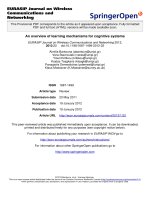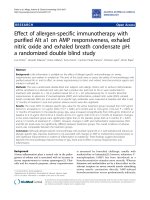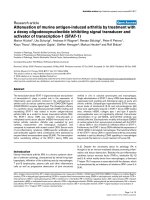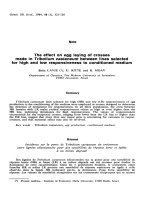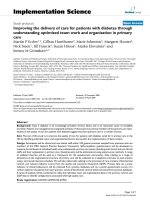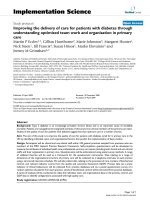- Trang chủ >>
- Khoa Học Tự Nhiên >>
- Vật lý
the effect of the hydrothermal treatment with aqueous naoh solution on the photocatalytic and photoelectrochemical propertiesof visible light-responsive TiO2thin films
Bạn đang xem bản rút gọn của tài liệu. Xem và tải ngay bản đầy đủ của tài liệu tại đây (1.13 MB, 6 trang )
The effect of the hydrothermal treatment with aqueous NaOH
solution on the photocatalytic and photoelectrochemical properties
of visible light-responsive TiO
2
thin films
Masaya Matsuoka
*
, Masaaki Kitano, Shohei Fukumoto, Kazushi Iyatani,
Masato Takeuchi, Masakazu Anpo
*
Department of Applied Chemistry, Graduate School of Engineering, Osaka Prefecture University, 1-1 Gakuen-cho,
Naka-ku, Sakai, Osaka 599-8531, Japan
Available online 1 February 2008
Abstract
The effect of the hydrothermal treatment with aqueous NaOH solution on the photoelectrochemical and photocatalytic properties of visible
light-responsive TiO
2
thin films prepared on Ti foil substrate (Vis-TiO
2
/Ti) by a radio-frequency magnetron sputtering (RF-MS) deposition method
has been investigated. The hydrothermally treated Vis-TiO
2
/Ti electrodes exhibited a significant increase in their photocurrent under UV and
visible light irradiation as compared to untreated Vis-TiO
2
/Ti electrode. SEM investigations revealed that the surface morphology of Vis-TiO
2
/Ti
are drastically changed from the assembly of the TiO
2
crystallites to the stacking of nanowires with diameters of 30–50 nm with increasing
hydrothermal treatment time (3–24 h), accompanying the increase in their surface area. The separate evolution of H
2
and O
2
from water under solar
light irradiation was successfully achieved using the Vis-TiO
2
/Ti/Pt which is hydrothermally treated for 5 h, while the H
2
evolution ratio was
15 mmol h
À1
in the early initial stage, corresponding to a solar energy conversion efficiency of 0.23%.
# 2008 Elsevier B.V. All rights reserved.
Keywords: Vis-TiO
2
thin film; Hydrothermal treatment; Photocatalyst; Visible and solar light; Water splitting reaction
1. Introduction
Recently, the water splitting reaction using photocatalysts
under visible or solar light irradiation has been regarded as an
ideal method of converting solar energy directly into clean fuel,
namely, hydrogen energy [1–12]. So far, several powdered
semiconducting oxides [2,3] or oxynitrides [4] have been found
to exhibit high activity for the water splitting reaction under
visible light irradiation. It has been also reported that TiO
2
catalysts deposited with Pt (Pt/TiO
2
) can decompose gaseous or
liquid water into H
2
and O
2
stoichiometrically under UV light
irradiation [5–7]. However, these TiO
2
catalysts can operate
only under UV light irradiation. Strongly desired is the
development of simple preparation method for visible light-
responsive TiO
2
photocatalysts. Previously, we have reported
the successful preparation of visible light-responsive TiO
2
(Vis-
TiO
2
) thin films by a radio-frequency magnetron sputtering
(RF-MS) deposition method at high substrate temperature and
their applications for the separate evolution reaction of H
2
and
O
2
from water under visible light irradiation [8–12]. However,
since the high substrate temperature (873 K) during deposition
leads to a small surface area of Vis-TiO
2
thin film, surface
modification processes are desired to enlarge its surface area.
Recently, Kasuga et al. have found that TiO
2
nanotubes can be
prepared by the simple one-step hydrothermal treatment of
TiO
2
crystals with NaOH aqueous solution [13,14]. Furt her-
more, it has been reported that nanowire TiO
2
thin films [15] as
well as rutile nanotube-like TiO
2
electrode [16] can be prepared
by hydrothermal treatment of calcined Ti foil in NaOH aqueous
solution and the films exhibited a remarkable enhancement in
the efficiency of photoelectrochemical oxidation of water [15]
or organic compounds [16] under UV light irradiation.
In the present work, Vis-TiO
2
thin films prepared on Ti foil
substrate were hydrothermally treated with NaOH aqueous
solution in order to improve their photoelectrochemical and
www.elsevier.com/locate/cattod
A
vailable online at www.sciencedirect.com
Catalysis Today 132 (2008) 159–164
* Corresponding authors.
E-mail addresses: (M. Matsuoka),
(M. Anpo).
0920-5861/$ – see front matter # 2008 Elsevier B.V. All rights reserved.
doi:10.1016/j.cattod.2007.12.032
photocatalytic performances through the chemical surface
modification. Special attentions will be focused on the effect of
the hydrothermal treatment of Vis-TiO
2
thin films on their
characteristics, photoelectrochemical properties, and photo-
catalytic activities for the separate evolution of H
2
and O
2
from
water under solar light irradiation.
2. Experimental
Vis-TiO
2
thin films were prepared on Ti foil substrate by an
RF-MS deposition method using a TiO
2
target (High Purity
Chemicals Lab., Corp., Grade: 99.99%) as the source material
and Ar gas (99.995%) as the sputtering gas. Before the
deposition of Vis-TiO
2
thin film, Ti foil substrate was calcined
at 723 K for 5 h in air. The calcined Ti foil substrate was
positioned within the camber of the RF-MS deposition
apparatus in the center parallel above the TiO
2
target as source
material at a target-to-substrate distance of 80 mm in
accordance with previous works [8–12]. The chamber was
evacuated to less than 6.0 Â 10
À4
Pa followed by the
introduction of Ar at 2.0 Pa. Vis-TiO
2
and UV-TiO
2
thin films
deposited on the Ti foil substrate (Vis-TiO
2
/Ti, UV-TiO
2
/Ti)
were then prepared by inducing an RF power of 300 W with the
substrate temperature at 873 K and 473 K, respectively.
According to our previous works [8–12], Vis-TiO
2
thin film
deposited on quartz substrate prepared in the same condition
exhibited considerable absorption in visible light regions, while
UV-TiO
2
thin films exhibited absorption only in the UV region
(l < 380 nm). Vis-TiO
2
/Ti were then reacted with 10 M NaOH
aqueous solution in a Teflon-lined stainless autoclave and kept
for 5–24 h at 393 K. After cooling down to room temperature,
the film s were washed with 0.1 M HCl solution. These
hydrothermally treated Vis-TiO
2
/Ti were referred to as
NaOH(X)-Vis-TiO
2
/Ti, where X is the time (h) of hydrothermal
treatment.
The surface morphologies of the films were examined by
scanning electron microscopy (SE M, S-4500, Hitachi) and the
crystal structures were investigated by X-ray diffractometer
analysis (XRD, XRD-6100, Shimadzu). The chemical compo-
sition of the thin films were investigated by X-ray photoelectron
spectroscopy (XPS, ESCA-3200, Shimadzu). The photoelec-
trochemical properties of the film electrodes (Vis-TiO
2
/Ti and
NaOH(X)-Vis-TiO
2
/Ti) were evaluated using a potentiostat
(HZ3000, Hokuto Denko) with a three-electrode cell that
consists of the film electrode, a Pt electrode and a saturated
calomel electrode (SCE) as the working, counter and reference
electrodes, respectively. The working electrode was irradiated
from the front side (light incident on the electrolyte/electrode
interface) by a 500 W Xe lamp through a color glass filter in
0.25 M K
2
SO
4
aqueous solution which was mechanically
stirred and degassed by purging with 99.99% pure Ar gas before
and during the experiment. The working electrode area was
about 0.2 cm
2
. The separate evolution of H
2
and O
2
from water
was investigated by using an H-type Pyrex glass container
connected to a conventional vacuum system (10
À3
Pa). The
detailed experimental procedures have been described in
previously reported works [8–12]. The back side of Vis-TiO
2
/Ti
or NaOH(X)-Vis-TiO
2
/Ti, where the Ti metal surface is
exposed, was deposited with Pt by an RF-MS deposition
method with an RF power of 70 W under a substrate
temperature at 298 K. These Pt-loaded TiO
2
thin films were
referred to as Vis-TiO
2
/Ti/Pt and NaOH(X)-Vis-TiO
2
/Ti/Pt. The
container consists of two water phases separated by a TiO
2
thin
film and proton-exchange membrane (Nafion film). Prior to the
reaction, the reaction cell was de-aerated by purging with
99.99% pure Ar gas for 3 h. Light irradiation was carried out
with a sunlight-gathering system (Laforet Engineering, XD-
50D) and the evolved H
2
and O
2
were analyzed by a gas
chromatograph (GC, G2800-T, Yanaco) with a thermal
conductivity detector (TCD).
3. Results and discussion
Photoelectrochemical measurements were performed using
a standard three-electrode system. Fig. 1 shows the current–
potential curves of Vis-TiO
2
/Ti and NaOH(5)-Vis-TiO
2
/Ti
electrodes. For both electrodes, anodic photocurrent increased
with an increase in anodic bias, while the dark current was
negligible under scanning potentials of À0.5 to +1.5 V versus
SCE. These results suggest the anodic oxidation of water to
oxygen by photogenerated holes occurs on these electrodes
under UV (l ! 300 nm) and visible light (l ! 420 nm)
irradiation. Furthermore, significant increase in the anodic
photocurrent under UV and visible light irradiation was
observed after hydrothermal treatment. As reported in previous
works, the Vis-TiO
2
thin film has a unique declined O/Ti
composition from the surface (2.00 Æ 0.01) to the deep inside
bulk (1.93 Æ 0.01) [8–12]. Such a unique anisotropic structure
Fig. 1. Current–potential curves of Vis-TiO
2
/Ti and NaOH(5)-Vis-TiO
2
/Ti
electrodes under UV (l ! 300 nm) and visible light (l ! 420 nm) irradiation.
Light source: 500 W Xe lamp.
M. Matsuoka et al. / Catalysis Today 132 (2008) 159–164160
was considered to play an import ant role in the modification of
the electronic properties, thus, enabling the absorption of
visible light.
Fig. 2 shows the anodic photocurrent of the NaOH(X)-Vis-
TiO
2
/Ti electrode as a function of the hydrothermal treatment
time with NaOH aqueous solution. These measur ements were
carried out with a bias of +1.0 V versus SCE in 0.25 M K
2
SO
4
aqueous solution. The observed photocurrents correspond to
the oxidation of H
2
O by the photoformed holes. Under UV
(l ! 300 nm) and visible light (l ! 420 nm) irradiation, the
anodic photocurrent increased with an increase in the
hydrothermal treatment time, reaching a maximum at 5 h
and then decreased above 7 h hydrothermal treatment. It should
be noted that the anodic photocurrent is increased by
hydrothermal treatment regardless of the hydrothermal treat-
ment time (3–24 h) as compared to that of the Vis-TiO
2
/Ti
electrode. Thus, it was clearly shown that hydrothermal
treatment with NaOH aqueous solution is effective for the
improvement of the photoelectrochemical performance of the
Vis-TiO
2
/Ti electrode.
Fig. 3 shows the SEM images of Vis-TiO
2
/Ti and NaOH(X)-
Vis-TiO
2
/Ti. Surface morphology of Vis-TiO
2
/Ti was drasti-
cally changed by the hydrothermal treatment. After 5 h
hydrothermal treatment, small sheet-like structures are started
to be observed on the surface of the large TiO
2
crystallites,
while these are completely covered with the accumulation of
sheet-like structures after hydrothermal treatment for 12 h.
After hydrothermal treatment for 24 h, complicated surface
structures consisting of the numerous stacking of nanowires
with diameters of 30–50 nm can be observed, showing a
remarkable contrast to the Vis-TiO
2
/Ti without hydrothermal
treatment. In addition , an increase in the surface areas was
Fig. 2. Anodic photocurrent of NaOH(X)-Vis-TiO
2
/Ti electrodes as a function
of the hydrothermal treatment time with NaOH aqueous solution under UV
(l ! 300 nm) and visible light irradiation (l ! 420 nm). Measurements were
performed under a bias of +1.0 V vs. SCE.
Fig. 3. SEM images of (a) Vis-TiO
2
/Ti and (b–d) NaOH(X)-Vis-TiO
2
/Ti.
M. Matsuoka et al. / Catalysis Today 132 (2008) 159–164 161
observed with increas ing hydrothermal treatment by BET
surface measurements as shown in Table 1 . The hydrothermal
treatment of Vis-TiO
2
thin film can be divided into two stages.
At the first stage (hydrothermal treatment time <5 h), the
surface morphology changes of Vis-TiO
2
thin films are not
significant, while the drastic increase in the surface areas as
well as the anodic photocurrents can be observed. At the second
stage (hydrothermal treatment time >5 h), the nanowire
structures start to be formed on Vis-TiO
2
thin film accompany-
ing the increase in the surface area, while the anodic
photocurrent gradually decreases with the increase in the
hydrothermal treatment time. From these results, it can be
considered that the drastic increase in the anodic photocurrent
is ascribed to the moderate surface modification by hydro-
thermal treatment within 5 h which increases the surface area of
Vis-TiO
2
thin film, while further hydrothermal treatment
decreases the anodic photocurrent through the structural
transformation of Vis-TiO
2
thin film into the inactive TiO
2
nanowires having high surface areas.
Fig. 4 shows the effect of the hydrothermal treatment on the
XRD patterns of Vis-TiO
2
/Ti. The intensity of the peaks due to
the rutile phase decreased with an increase in the hydrothermal
treatment time, and at the same time, the peaks due to titanates
at 2u of around 108 start to be observed [17]. The decrease in the
photocurrent after prolonged hydrothermal treatment can,
therefore, be ascribed to the formation of titanates such as
A
2
Ti
3
O
7
or A
2
Ti
2
O
5
H
2
O, where A represents Na and/or H
[17]. Fig. 5 shows the Ti 2p and Na 1s XPS spectra of the Vis-
TiO
2
/Ti before and after hydrothermal treatment. The intensity
of the Ti 2p peaks due to Ti
4+
(Ti 2p
3/2
: 459 eV, Ti 2p
1/2
:
465 eV) [18] scarcely changed after hydrothermal treatment,
Table 1
Surface areas of Vis-TiO
2
/Ti and NaOH(X)-Vis-TiO
2
/Ti
Sample A
bet
a
(cm
2
)
Vis-TiO
2
/Ti 467
NaOH(5)-Vis-TiO
2
/Ti 716
NaOH(12)-Vis-TiO
2
/Ti 1328
NaOH(24)-Vis-TiO
2
/Ti 3040
a
Sample size: 5 mm  20 mm.
Fig. 4. (a) XRD patterns of Vis-TiO
2
/Ti and NaOH(X)-Vis-TiO
2
/Ti and (b) the expanded XRD patterns of (a) (2u = 5–158).
Fig. 5. XPS spectra of the Ti 2p (right) and Na 1s (left) peaks of the Vis-TiO
2
/Ti and NaOH(X)-Vis-TiO
2
/Ti.
M. Matsuoka et al. / Catalysis Today 132 (2008) 159–164162
while the intensity of the Na 1s peak around 1072 eV increased
at the same time [19]. These results suggest that the decrease in
the photocurrent after prolonged hydrothermal treatment can
also be ascribed to the existence of small amounts of Na
+
which
enhances the recombination rate of the photoformed electrons
and holes.
The photocatalytic activities of Vis-TiO
2
/Ti/Pt or NaOH(5)-
Vis-TiO
2
/Ti/Pt were investigated by the separate evolution of
H
2
and O
2
from water under solar light irradiation. Vis-TiO
2
/Ti/
Pt or NaOH(5)-Vis-TiO
2
/Ti/Pt are mounted at the center of an
H-type glass container, separating two aqueous solutions, as
shown in Fig. 6. A Nafion film is also mounted on the H-type
glass container to provide the electrical connections which
allow the electron transfer between the two separated aqueous
phases, playing the same role as a salt bridge between two
aqueous phases. The TiO
2
side of the photocatalyst was
immersed into 1.0 M NaOH and the Pt side was immersed into
0.5 M H
2
SO
4
aqueous solution in order to add a small chemical
bias (0.826 V) to assist the electron transfer from the TiO
2
into
the Pt side through the metal substrate. Fig. 7 shows the
separate evolution reaction of H
2
and O
2
under solar light
irradiation using sunlight-gathering system that removes almost
all the UV rays found in sunlight. Water was decomposed into
H
2
and O
2
separately with a good linearity against the
irradiation time and NaOH(5)-Vis-TiO
2
/Ti/Pt exhibited much
higher activity than Vis-TiO
2
/Ti/Pt. From the initial slope of the
plot, the evolution rate of H
2
on NaOH(5)-Vis-TiO
2
/Ti/Pt was
estimated at about 15 mmol h
À1
, showing that the total solar
energy conversion efficiency (h) in the presence of an external
applied potential was 0.23% determined by the following
equation [20]:
h ð%Þ¼
100 jð1:23 À E
app
Þ
I
0
(1)
where j is the current density (mA/cm
2
) estimated from the H
2
evolution rate, E
app
is the applied chemical bias (0.826 V) and
I
0
is the intensity of the incident light (mW/cm
2
).
It should be noted that UV-TiO
2
/Ti/Pt does not exhibit any
activity for the separate evolution of H
2
and O
2
from water
under solar light irradiation. Thus, the hydrothermally treated
Vis-TiO
2
thin films were found to act as efficient photocatalysts
for the separate evolution of H
2
and O
2
from water under solar
light irradiation.
4. Conclusions
Vis-TiO
2
thin films were prepared on Ti foil substrate by RF-
MS deposition method at high substrate temperature (873 K). It
was found that the hydrothermal treatment of the Vis-TiO
2
/Ti
with NaOH aqueous solution led to the drastic increase in the
surface area of Vis-TiO
2
/Ti as well as an enhancement of the
anodic photocurrent under UV and visible light irradiation. The
highest anodic photocurrent was obtained after 5 h hydrothermal
treatment. The separate evolution of H
2
and O
2
from water under
smallchemicalbias wereinvestigated under solarlight irradiation
anditwaselucidated that thehydrothermally treated Vis-TiO
2
/Ti/
Pt thin films act as efficient photocatalysts for the separate
evolution of H
2
and O
2
from water with a solar energy conversion
efficiency of 0.23%. The hydrothermally treated Vis-TiO
2
/Ti/Pt
could, thus, be considered a unique photofunctional material for
applications in clean and safe H
2
production systems from water
using abundant and pollution-free resource, solar energy.
References
[1] A. Fujishima, T.N. Rao, D.A. Tryk, J. Photochem. Photobiol. C: Photo-
chem. Rev. 1 (2000) 1.
[2] R. Niishiro, H. Kudo, A. Kudo, Phys. Chem. Chem. Phys. 7 (2005) 2241.
[3] Z. Zou, J. Ye, K. Sayama, H. Arakawa, Nature 414 (2001) 625.
[4] K. Maeda, K. Teramura, D. Lu, T. Takata, N. Saito, Y. Inoue, K. Domen,
Nature 440 (2006) 295.
[5] K. Yamaguchi, S. Sato, J. Chem. Soc., Faraday Trans. 1 (81) (1985) 1237.
Fig. 6. H-type glass container for the separate evolution of H
2
and O
2
using Vis-
TiO
2
/Ti/Pt or NaOH(X)-Vis-TiO
2
/Ti/Pt (TiO
2
side: 1.0 M NaOH aq; Pt side:
0.5 M H
2
SO
4
aq).
Fig. 7. Reaction time profiles of the separate evolution of (*)H
2
and (~)O
2
under solar light irradiation on NaOH(5)-Vis-TiO
2
/Ti/Pt, Vis-TiO
2
/Ti/Pt and
UV-TiO
2
/Ti/Pt in an H-type glass container and the time profile of the relative
intensity of sunlight. Irradiation area: 10 mm  20 mm.
M. Matsuoka et al. / Catalysis Today 132 (2008) 159–164 163
[6] S. Tabata, H. Nishida, Y. Masaki, K. Tabata, Catal. Lett. 34 (1995) 245.
[7] H. Kominami, S. Murakami, M. Kohno, Y. Kera, K. Okada, B. Ohtani,
Phys. Chem. Chem. Phys. 3 (2001) 4102.
[8] M. Anpo, M. Takeuchi, J. Catal. 216 (2003) 505.
[9] M. Matsuoka, M. Kitano, M. Takeuchi, M. Anpo, J.M. Thomas, Top.
Catal. 35 (2005) 305.
[10] M. Kitano, K. Tsujimaru, M. Anpo, Appl. Catal. A: Gen. 314 (2006) 179.
[11] M. Kitano, M. Takeuchi, M. Matsuoka, J.M. Thomas, M. Anpo, Catal.
Today 120 (2007) 133.
[12] M. Matsuoka, M. Kitano, M. Takeuchi, K. Tsujimaru, M. Anpo, J.M.
Thomas, Catal. Today 122 (2005) 51.
[13] T. Kasuga, M. Hiramatsu, A. Hoson, T. Sekino, K. Niihara, Langmuir 14
(1998) 3163.
[14] T. Kasuga, M. Hiramatsu, A. Hoson, T. Sekino, K. Niihara, Adv. Mater. 15
(1999) 1307.
[15] M. Kitano, M. Ueshima, M. Matsuoka, M. Anpo, Abstracts of Spring
Meeting of Japan Society of Powder and Powder Metallurgy, The Japan
Society of Powder and Powder Metallurgy, Tokyo, 2006, p. 147.
[16] S.G. Yang, X. Quan, X.Y. Li, C. Sun, Photochem. Photobiol. Sci. 5 (2006)
808.
[17] J.N. Nian, H. Teng, J. Phys. Chem. B 110 (2006) 4193.
[18] B. Erdem, R.A. Hunsicker, G.W. Simmons, E.D. Sudol, V.L. Dimonie,
M.S. El-Aasser, Langmuir 17 (2001) 2664.
[19] E. Ksepko, E. Talik, A. Ratuszna, A. Molak, Z. Ujma, I. Gruszka, J. Alloys
Compd. 386 (2005) 35.
[20] S.U.M. Khan, M. Al-Shahry, W.B. Ingler Jr., Science 297 (2002) 2243.
M. Matsuoka et al. / Catalysis Today 132 (2008) 159–164164

